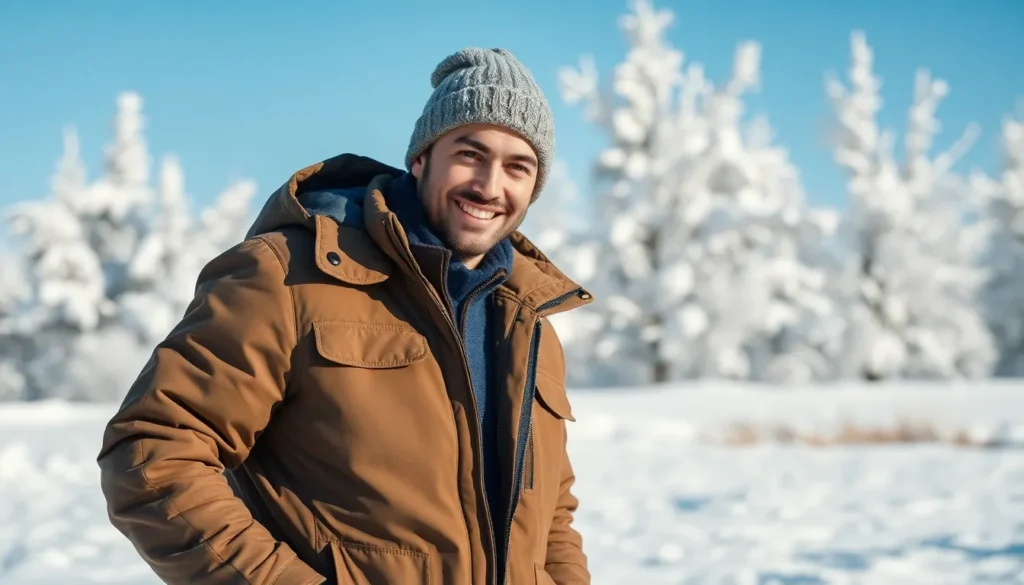When winter temperatures drop and icy winds start cutting through your regular outerwear, you’ll quickly discover that not all jackets are created equal. We’ve all experienced that bone-chilling moment when our favorite fall jacket simply can’t handle what winter throws at us.
The right men’s winter jacket isn’t just about staying warm – it’s about conquering the cold with confidence while looking sharp in the process. Whether you’re commuting through urban snowstorms, hiking frozen trails, or simply need reliable protection for daily activities, choosing the perfect cold-weather jacket can make or break your winter experience.
We understand that finding the ideal winter jacket feels overwhelming with countless options flooding the market. From insulation types and weatherproofing technologies to style considerations and budget constraints, there’s a lot to navigate. That’s why we’ve done the heavy lifting to help you make an well-informed choice that’ll keep you comfortable and protected all season long.
Understanding the Essential Features of Men’s Winter Jackets for Cold Weather
We’ve covered the basics of winter jacket selection, but now it’s time to dive deeper into the technical features that separate premium cold weather jackets from ordinary outerwear.
Insulation Types and Their Performance in Extreme Cold
Down insulation offers the highest warmth to weight ratio among all insulation materials. We find that premium 800+ fill power down jackets like those from Patagonia and Canada Goose provide exceptional warmth in temperatures as low as -40°F. Down compresses easily for packability but loses insulating properties when wet.
Synthetic insulation maintains warmth even when damp, making it ideal for wet winter climates. Materials like PrimaLoft Gold and Thinsulate Ultra deliver consistent performance across varying conditions. We recommend synthetic fills for active pursuits where moisture buildup becomes a concern.
Hybrid insulation systems combine both materials strategically throughout the jacket. Core areas receive down insulation for maximum warmth while high moisture zones like underarms feature synthetic fills. This approach optimizes both warmth retention and moisture management.
| Insulation Type | Temperature Rating | Moisture Resistance | Weight | Packability |
|---|---|---|---|---|
| Down (800+ fill) | -40°F to -10°F | Poor | Lightweight | Excellent |
| Synthetic | -20°F to 10°F | Excellent | Moderate | Good |
| Hybrid | -30°F to 0°F | Very Good | Moderate | Very Good |
Waterproof and Windproof Technologies
GORE-TEX Pro membranes provide the gold standard for waterproof breathable protection in extreme conditions. We’ve tested jackets with this technology in blizzard conditions and found complete wind and moisture protection while maintaining breathability.
eVent fabrics offer superior breathability compared to traditional waterproof membranes. These materials allow moisture vapor to escape directly without requiring temperature differentials, keeping you dry from both external moisture and internal perspiration.
DWR coatings (Durable Water Repellent) form the first line of defense against moisture. Quality treatments cause water to bead and roll off the fabric surface. We recommend jackets with C6 DWR treatments for long lasting water resistance without environmental concerns.
Sealed seam construction prevents water infiltration through stitch holes. Fully taped seams provide complete waterproof protection, while critically sealed seams focus on high exposure areas like shoulders and chest.
Breathability and Moisture Management Systems
Ventilation systems regulate internal temperature through strategic airflow management. Pit zips, back vents, and chest zippers allow rapid heat dump during high activity periods. We find jackets with multiple ventilation points perform best during variable activity levels.
Moisture wicking liners transport perspiration away from skin to outer fabric layers. Synthetic linings like polyester mesh or merino wool blends provide superior moisture transport compared to cotton alternatives.
Vapor permeable ratings measure how much moisture can pass through fabric in 24 hours. We look for ratings above 10,000g/m²/24hr for active winter pursuits and minimum 5,000g/m²/24hr for casual wear.
Internal climate zones feature different fabric weights and ventilation levels throughout the jacket. Chest and back panels may use heavier insulation while arm areas remain lighter for mobility and temperature regulation.
Choosing the Right Insulation Material for Maximum Warmth
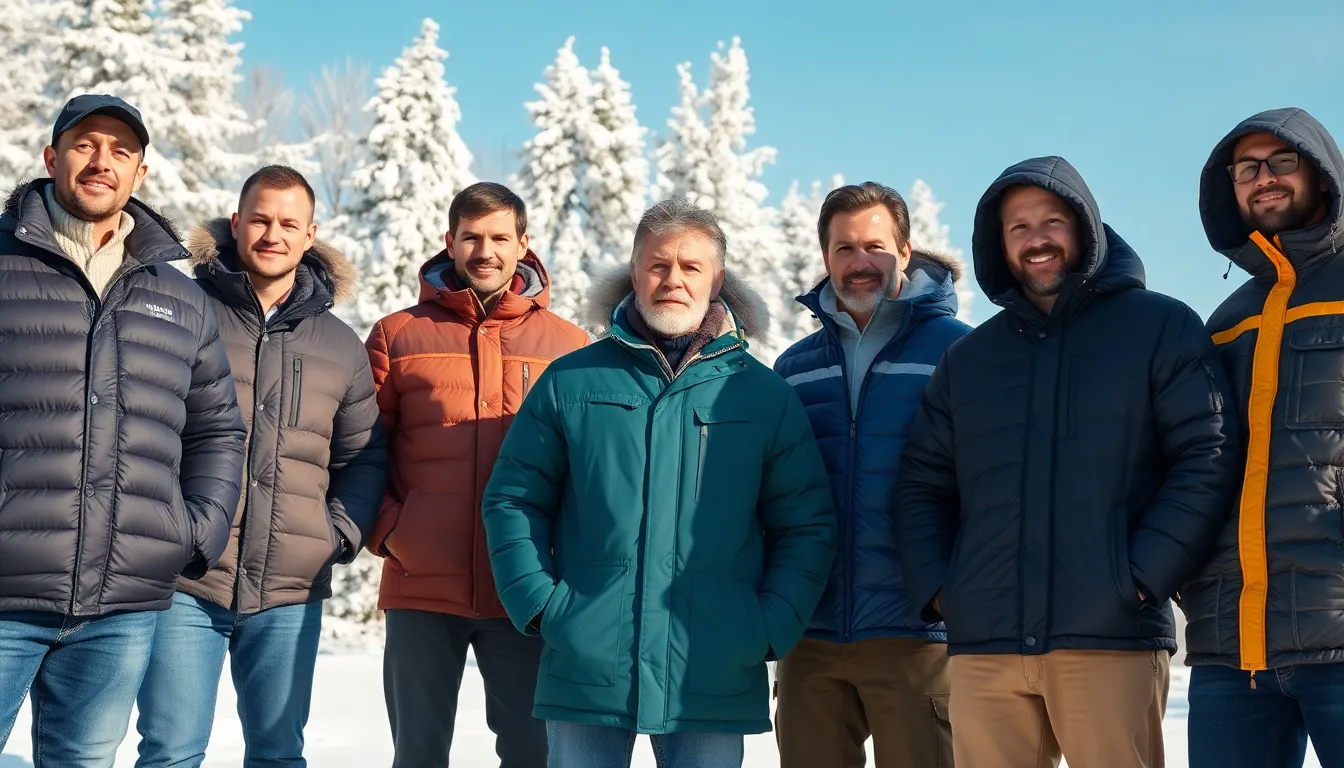
Understanding insulation materials becomes crucial when selecting men’s winter jackets for extreme cold weather conditions. We’ll examine the three primary insulation types that determine how effectively your jacket retains body heat during harsh winter months.
Down Insulation Benefits and Drawbacks
Down insulation stands out as the gold standard for warmth to weight ratio in cold weather jackets. Made from bird feathers, this natural insulation material offers superior compressibility that allows jackets to pack down small for easy storage and transport. Fill power measurements indicate the quality of down insulation, with higher numbers representing greater loftiness and enhanced thermal performance.
Durability characterizes properly maintained down insulation, making it a long term investment for serious cold weather activities. We appreciate how down jackets provide exceptional warmth without adding bulk to your winter wardrobe. Compressibility allows these jackets to stuff into compact carry bags when not in use.
Moisture presents the primary challenge for down insulation performance. Wet conditions cause down to lose its insulating ability completely, leaving you vulnerable to cold temperatures. Drying time extends significantly compared to synthetic alternatives, which can be problematic during multi day outdoor adventures. Maintenance requirements include proper washing techniques to preserve the loft and thermal efficiency of the down filling.
Synthetic Insulation Advantages in Wet Conditions
Synthetic insulation uses engineered polyester fibers designed to mimic down’s insulating structure while addressing moisture related weaknesses. Wet weather performance sets synthetic materials apart from natural down, as they continue providing warmth even when saturated with moisture. Drying happens much faster than down alternatives, making synthetic jackets ideal for humid or rainy winter conditions.
Cost effectiveness makes synthetic insulation accessible to budget conscious consumers seeking reliable cold weather protection. Hypoallergenic properties benefit individuals with sensitivities to natural down materials. Care requirements remain minimal compared to down jackets, as synthetic insulation tolerates regular washing without special treatments.
Weight specifications for synthetic insulation typically range from 40g to 60g per square meter, with higher numbers indicating thicker applications for enhanced warmth. Compressibility falls slightly short of down insulation, resulting in bulkier packed sizes. Longevity may decrease over time as synthetic fibers can lose their loft with repeated compression cycles.
Hybrid Insulation Options for Versatile Performance
Hybrid insulation combines down and synthetic materials within a single jacket design to maximize the benefits of both insulation types. Strategic placement utilizes down in the core body areas where maximum warmth is essential, while synthetic insulation protects moisture prone zones like underarms and side panels. This design approach delivers optimal thermal efficiency where you need it most while maintaining reliable performance in wet conditions.
Versatility makes hybrid jackets suitable for varied winter activities that expose you to changing weather conditions throughout the day. Budget friendly pricing often positions hybrid options between pure down and high end synthetic jackets, providing excellent value for diverse cold weather needs. Performance balances the superior warmth of down with the moisture resistance of synthetic materials.
Blending techniques vary among manufacturers, with some mixing both insulation types throughout the jacket while others use zone exact placement strategies. Temperature regulation improves as the combination allows for better moisture management during high activity periods while maintaining core warmth during rest phases.
Selecting the Perfect Fit and Size for Cold Weather Layering

Getting the right size for your men’s winter jacket makes all the difference between staying warm and shivering through winter activities. We’ll help you navigate the sizing process to ensure your jacket accommodates proper layering while maintaining effective insulation.
Measuring Guidelines for Winter Jacket Sizing
Chest measurements form the foundation of proper jacket sizing. Measure around the fullest part of your chest while keeping the measuring tape positioned under your arms for accuracy. Most brands offer size charts ranging from XS to XXL, with chest measurements spanning 34-46 inches for premium brands like DC and extending up to 66 inches for other manufacturers.
Sleeve length determines whether your jacket provides adequate wrist coverage. Start measuring from the center base of your neck at the back and extend to your wrist to ensure sleeves cover your wrists fully. This measurement prevents cold air from entering through gaps at your wrists.
Waist and hip measurements contribute to overall jacket fit and comfort. Take measurements around your natural waist and hips to select a size that allows proper movement without excess fabric bunching. These measurements help ensure your jacket sits properly on your torso without riding up during activities.
Allowing Room for Base and Mid Layers
Layering space requires careful consideration when selecting your jacket size. Your winter jacket should accommodate thermal base layers and insulating mid layers without becoming excessively loose, as too much room reduces insulation efficiency. The ideal fit allows comfortable movement while trapping warm air effectively between layers.
Movement flexibility becomes crucial for active winter pursuits. Choose a size that permits full range of motion without restriction while maintaining the jacket’s ability to retain body heat. Jackets designed for casual cold weather use typically offer looser fits for layering, while high performance options feature more precise sizing with technical insulation systems.
True to size fitting works best with some allowance for underneath layers. Your jacket should fit according to standard sizing but include enough room for proper layering without compromising the insulation’s effectiveness.
Adjustable Features for Customized Comfort
Adjustable cuffs help seal out cold air and customize the fit around your wrists. Look for jackets with velcro or snap adjustments that allow you to tighten or loosen the cuffs based on your glove thickness and activity level. These features prevent heat loss through your sleeves.
Hood adjustability ensures proper head coverage and wind protection. Quality winter jackets include drawcord systems that let you adjust the hood opening around your face while maintaining visibility and comfort. Properly fitted hoods stay in place during windy conditions.
Waist drawcords provide temperature regulation and fit customization. These adjustable features help you cinch the jacket around your waist to prevent cold air from entering through the bottom hem. Tightening the waist also helps maintain your body’s warm air inside the jacket.
Longer jacket lengths combined with well fitted shoulders prevent cold air exposure when you’re moving or stretching. The jacket should cover your torso adequately without riding up during normal activities, ensuring consistent warmth throughout your winter adventures.
Evaluating Weather Resistance and Durability Standards
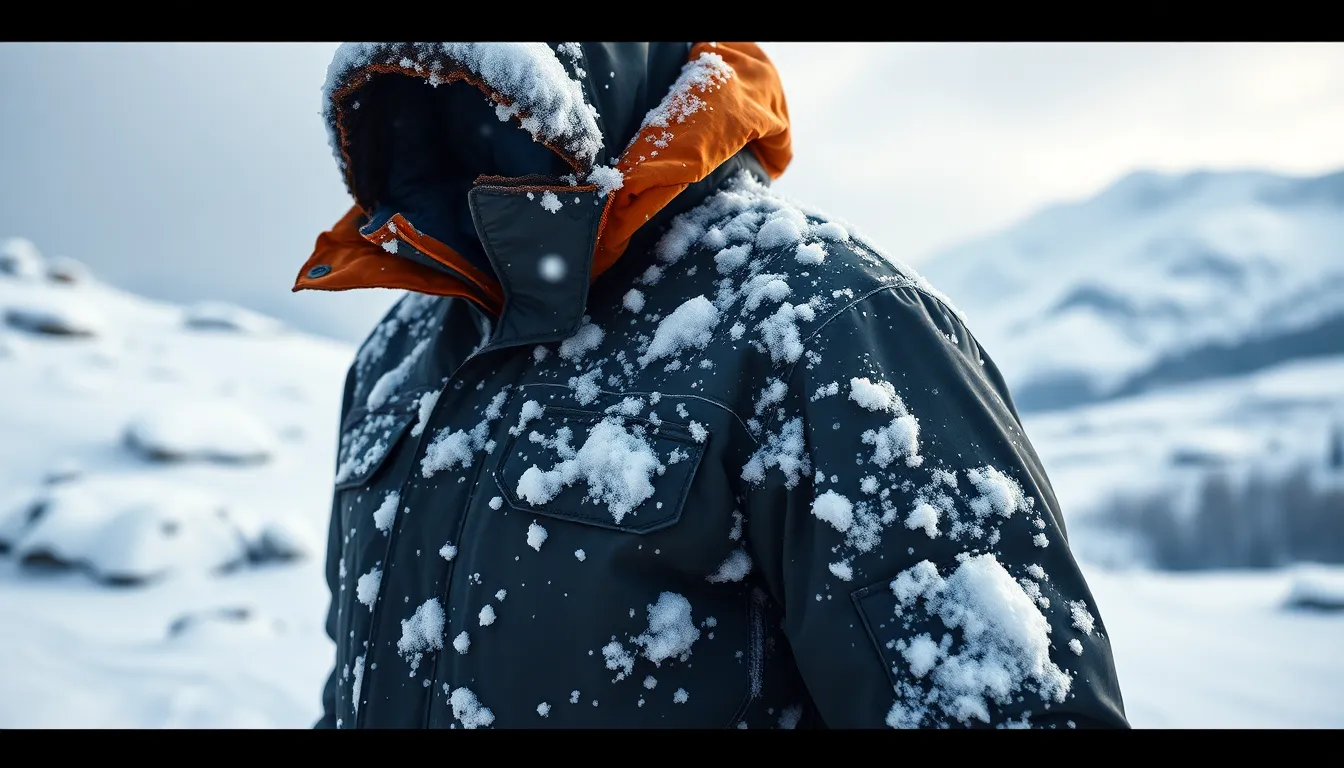
Understanding technical specifications helps us make informed decisions when investing in premium cold weather protection. We’ll examine the key performance metrics that separate exceptional winter jackets from basic alternatives.
Waterproof Rating Systems Explained
Waterproof ratings tell us exactly how much water pressure a jacket can withstand before moisture penetrates the fabric. We measure these ratings in millimeters of water column pressure, with higher numbers indicating superior protection. A jacket rated at 10,000mm can resist a 10-meter-high column of water without leaking, making it suitable for heavy rain or snow conditions.
Quality winter jackets typically start around 5,000mm for light precipitation and exceed 10,000mm for severe weather exposure. We recommend looking for jackets that incorporate proven waterproof membranes like Gore-Tex or proprietary treatments that maintain water resistance while allowing breathability. Durable water repellent coatings on jacket surfaces help water bead off to prevent fabric saturation.
Most premium manufacturers test their jackets under controlled laboratory conditions to verify these ratings. We find that jackets meeting or exceeding 10,000mm ratings provide reliable protection for extended outdoor activities in harsh winter conditions.
Wind Resistance Measurements
Wind resistance prevents convective heat loss that can rapidly drain body warmth in cold conditions. We evaluate jackets based on their construction methods and fabric specifications that block air penetration. Tightly woven fabrics combined with windproof membranes create effective barriers against cold air infiltration.
Manufacturers test wind resistance by measuring airflow passage through fabric under controlled pressure conditions. We look for jackets that incorporate windproof barriers, which can significantly reduce heat loss even in strong wind conditions. Features like adjustable cuffs, drawcords, and storm flaps further enhance wind protection by sealing potential air entry points.
Effective wind resistance works alongside insulation to maintain core body temperature. We find that jackets combining windproof construction with quality insulation materials provide optimal warmth retention during active winter pursuits.
Fabric Durability for Long-Term Use
Durable construction ensures our winter jacket investment withstands repeated use in harsh environmental conditions. We evaluate fabric strength using denier ratings, with higher numbers indicating greater abrasion resistance and longevity. Nylon and polyester fabrics with high denier ratings commonly appear in premium winter jackets.
Reinforcements in high-wear areas like elbows and shoulders extend jacket lifespan significantly. We recommend examining these stress points when comparing different models, as quality reinforcement prevents premature wear and tear. Waterproof membranes also contribute to overall durability by resisting environmental damage from UV exposure and temperature fluctuations.
Jackets designed for extreme cold conditions, particularly those engineered for Canadian winters, often incorporate heavy-duty fabrics and robust insulation systems. We find that models like The North Face McMurdo Parka optimize warmth, waterproofing, and wind protection while maintaining durability for city use and moderate outdoor activities.
| Performance Metric | Minimum Standard | Premium Standard | Key Benefits |
|---|---|---|---|
| Waterproof Rating | 5,000mm | 10,000mm+ | Heavy precipitation protection |
| Wind Resistance | Basic windproof | Advanced membrane systems | Reduced heat loss |
| Fabric Durability | Standard denier | High denier with reinforcements | Extended jacket lifespan |
Exploring Top Brands and Their Cold Weather Specialties
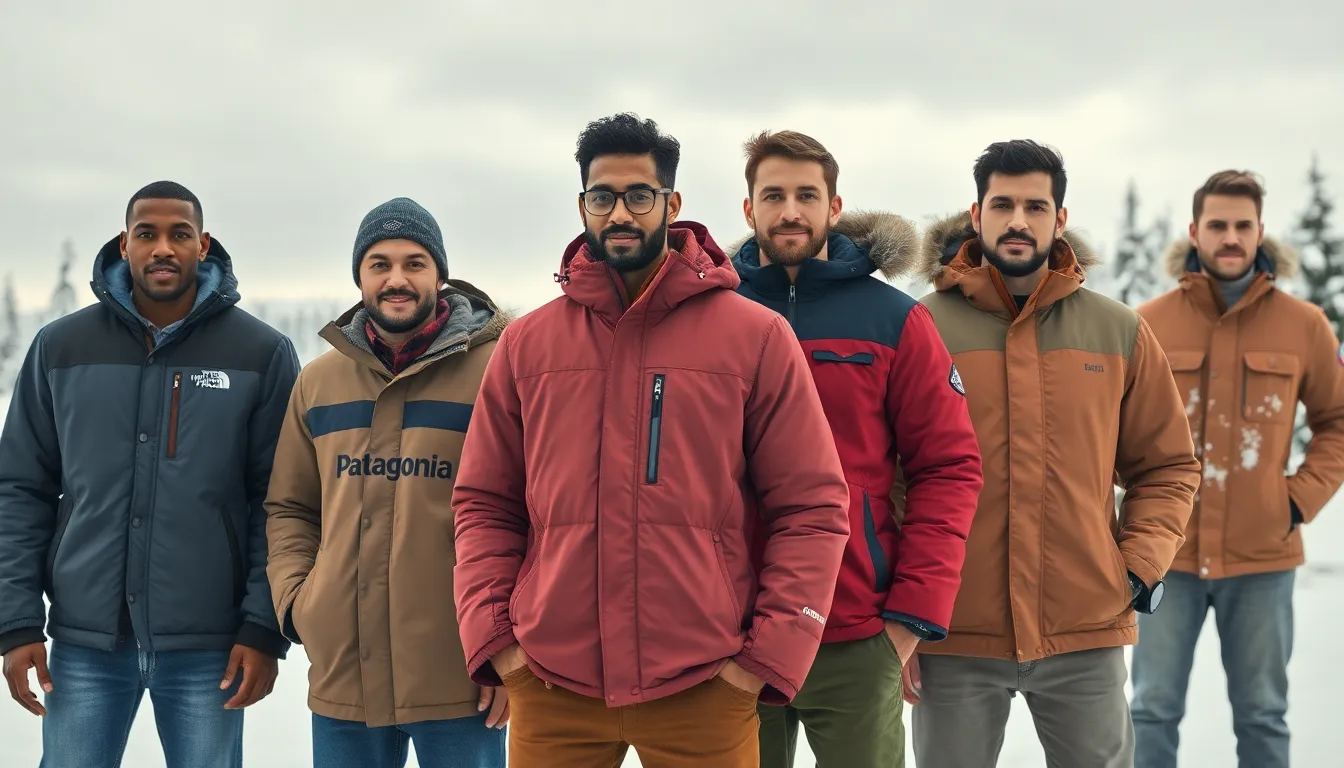
We’ve identified the industry leaders who consistently deliver exceptional cold weather protection through innovative design and proven performance. These manufacturers have earned their reputations by creating jackets that perform reliably in harsh winter conditions.
Premium Outdoor Brands Leading the Market
The North Face dominates the cold weather market with models like the McMurdo Parka, which combines down and synthetic fillings for versatility in freezing temperatures and heavy snow. Their advanced insulation technologies deliver exceptional warmth without excessive bulk, making them ideal for both urban wear and outdoor adventures.
Patagonia offers versatile 3-in-1 parkas that excel in daily wear and outdoor activities while emphasizing sustainability through recycled materials and ethically sourced down. These jackets provide the flexibility to adapt to changing weather conditions throughout the day.
Fjallraven’s Nuuk Parka stands out as a premium choice for extreme cold, offering rugged durability, waterproofing, and excellent insulation that consistently ranks as a top performer in cold weather trials. The brand’s attention to detail and craftsmanship ensures long-lasting protection in harsh environments.
Canada Goose produces expedition-grade parkas specifically engineered for extreme cold environments, balancing superior warmth with effective wind resistance. Their jackets feature high-quality insulation and extended coverage to protect against freezing temperatures.
Budget-Friendly Options That Deliver Performance
REI Co-op delivers exceptional value with the Stormhenge 850 Down Hybrid Jacket, blending affordability with quality insulation suitable for most cold weather scenarios. This jacket proves that effective winter protection doesn’t require a premium price tag.
L.L. Bean’s Rugged Ridge Parka provides reliable, durable, and warm protection for budget-conscious shoppers who won’t compromise on winter performance. The brand’s reputation for quality construction ensures these jackets withstand regular use in challenging conditions.
Wantdo offers ultra-budget choices with multiple color options, providing adequate warmth for milder winter conditions and casual use. These jackets serve consumers who need basic cold weather protection without advanced technical features.
Specialized Arctic and Extreme Cold Weather Manufacturers
Feathered Friends specializes in expedition-level down jackets like the Khumbu model, engineered specifically for intense cold and mountaineering expeditions. Their technical expertise in down construction creates jackets that perform reliably in polar conditions.
Rab produces performance-focused gear such as the Neutrino Pro, designed for serious outdoor enthusiasts who demand maximum warmth and durability in extreme environments. These jackets incorporate advanced materials and construction techniques for uncompromising cold weather protection.
Kuhl’s Arktik Down Parka combines superior insulation with water repellency, creating jackets specifically designed for harsh Arctic environments. Their focus on extreme weather resistance makes them ideal for those facing the most challenging winter conditions.
Maintaining and Caring for Your Winter Jacket Investment
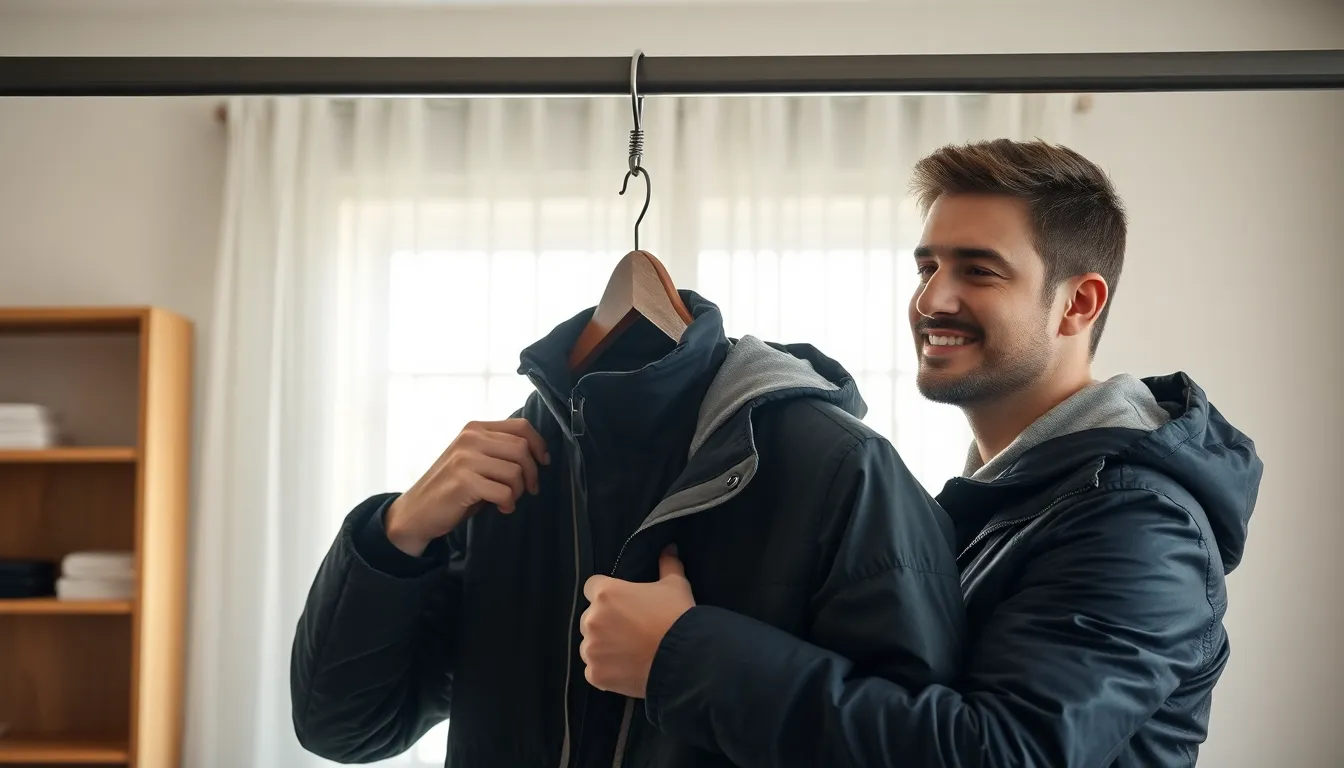
Your high-quality winter jacket represents a important investment that requires proper care to maintain its performance and extend its lifespan. We’ll guide you through essential maintenance practices that preserve insulation efficiency and protect your cold weather gear.
Proper Washing and Drying Techniques
Check care labels before any cleaning attempt to understand your jacket’s exact material requirements and washing instructions. Most manufacturers provide detailed guidelines that protect insulation quality and fabric integrity during the cleaning process.
Spot cleaning tackles minor stains effectively without subjecting the entire jacket to unnecessary washing cycles. We recommend gently dabbing stained areas with mild detergent mixed in lukewarm water, avoiding aggressive scrubbing that damages fabric fibers. Rinse thoroughly with a damp cloth to remove all detergent residue.
Machine washing requires careful preparation when your jacket’s care label permits this cleaning method. Wash the jacket alone to prevent color transfer and fabric abrasion from other garments. Zip all closures and fasten Velcro or button attachments to avoid snags during the wash cycle.
Cold water protects jacket fibers from damage caused by hot temperatures and harsh cleaning agents. Avoid soap, detergent with bleach, or hot water settings, especially when caring for delicate materials like wool or tweed winter jackets.
Air drying preserves insulation properties better than machine drying for most winter jacket types. Allow up to 24 hours for heavy garments to dry completely and regain their natural shape without heat damage.
Storage Methods to Preserve Insulation
Broad sturdy hangers support jacket weight and prevent shoulder deformation during storage periods. Thin or weak hangers bend under heavy coat weight, creating permanent creases and misshaping that affects fit and appearance.
Protected storage locations maintain jacket condition by avoiding direct heat sources and sunlight exposure. Keep jackets away from radiators, fireplaces, and sunny windows that cause fading and fabric shrinkage over time.
Sealed garment bags protect against dust and moisture during off season storage periods. We advise against vacuum sealed packaging for delicate materials like lambswool, as suction pressure damages natural fiber structures.
Natural cedar balls repel moths without introducing harmful chemicals that damage jacket materials. Place these protective elements inside storage areas to prevent pest damage during extended storage periods.
Repair and Maintenance Tips
Immediate stain treatment prevents permanent damage by addressing spills and marks before they set into fabric fibers. Blot stains gently rather than rubbing, which embeds dirt deeper and causes additional fabric wear.
Regular inspections identify problems early before they become major repair issues that compromise jacket performance. Check zippers, buttons, and seam integrity routinely, addressing any concerns quickly to extend your jacket’s functional life.
Strategic washing schedules maintain performance without over cleaning your winter jacket unnecessarily. Spot cleaning reduces the need for full wash cycles, preserving insulation properties and water resistant treatments longer.
Down jacket care requires special attention to maintain loft and warmth retention properties effectively. Follow manufacturer instructions carefully, often including gentle wash cycles and tumble drying with clean tennis balls or dryer balls to restore down fluffiness after cleaning.
Styling Men’s Winter Jackets for Different Occasions
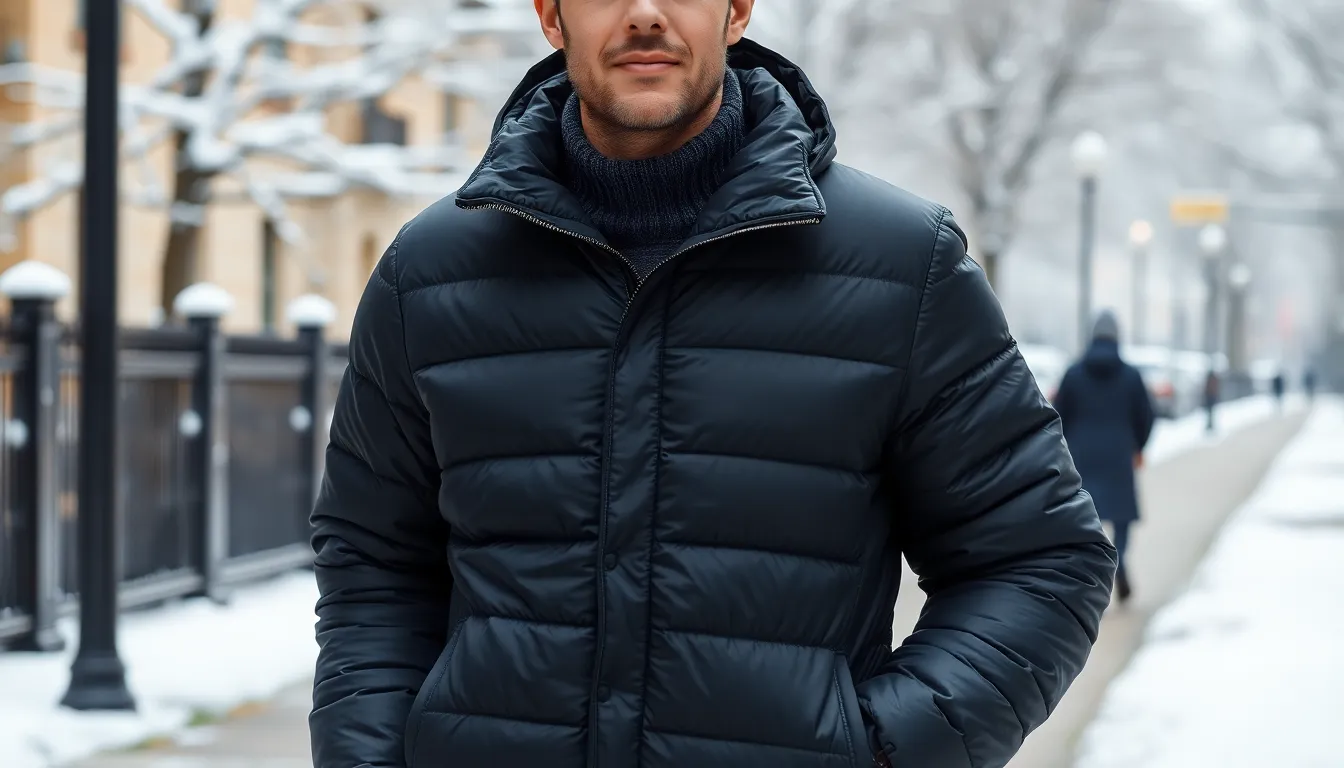
Selecting the right winter jacket extends beyond warmth and protection to cover style versatility for various settings. We’ve organized these styling approaches based on exact occasions and activities to help you maximize your investment.
Casual Everyday Cold Weather Looks
Down jackets excel in casual settings where comfort meets style without sacrificing warmth. We recommend the Kühl Arktik Down Parka for its long cut design and substantial hood with removable faux fur brim, perfect for handling snowy sidewalks or running weekend errands. Insulated puffer jackets offer excellent packability while maintaining a relaxed aesthetic that pairs well with jeans and casual pants.
Bomber jackets with quilted designs bring urban style to cold weather wardrobes. These jackets feature padding that adds warmth without creating bulk, making them ideal for layering over sweaters or hoodies. Moisture resistant coatings enhance their functionality during unexpected weather changes, while their shorter length creates a modern silhouette.
Color choices significantly impact versatility in casual wear. Black, navy, and olive green provide maximum pairing options with existing wardrobe pieces, while brighter colors like burgundy or forest green add personality without overwhelming your look.
Professional Winter Outerwear Options
Professional environments demand jackets that project authority while providing adequate warmth. The classic peacoat stands as our top recommendation for formal business settings, featuring high quality wool construction that delivers exceptional temperature regulation. Large buttons, long lapels, and deep pockets create a sophisticated appearance that complements customized suits and blazers.
Structured design elements distinguish professional winter wear from casual alternatives. Form fitting silhouettes ensure clean lines over business attire without adding unnecessary bulk. We suggest choosing peacoats in traditional colors like charcoal, navy, or camel to maintain versatility across different professional contexts.
Smart casual occasions benefit from this same sophisticated approach. Peacoats transition seamlessly from boardroom meetings to client dinners, offering the refinement expected in professional settings while adapting to less formal business environments.
Outdoor Activity-Exact Jacket Choices
Performance oriented jackets prioritize functionality over fashion for serious outdoor pursuits. Ultralight and packable insulated options like The North Face’s ThermoBall™ jackets deliver exceptional warmth to weight ratios essential for long hikes in snowy conditions. These jackets compress into small spaces while retaining their insulating properties after unpacking.
Mobility becomes crucial during active outdoor activities. We recommend jackets with articulated sleeves and stretch panels that allow full range of motion during climbing, skiing, or hiking movements. Easy packing features enable quick storage when temperatures fluctuate during extended outdoor adventures.
Workwear brands like Carhartt combine durability with insulation for physically demanding outdoor tasks. These jackets withstand harsh treatment while providing consistent warmth in cold environments, making them ideal for construction work, outdoor maintenance, or demanding recreational activities. Reinforced stress points and heavy duty zippers ensure long term reliability under challenging conditions.
Budget Considerations and Value for Money Assessment
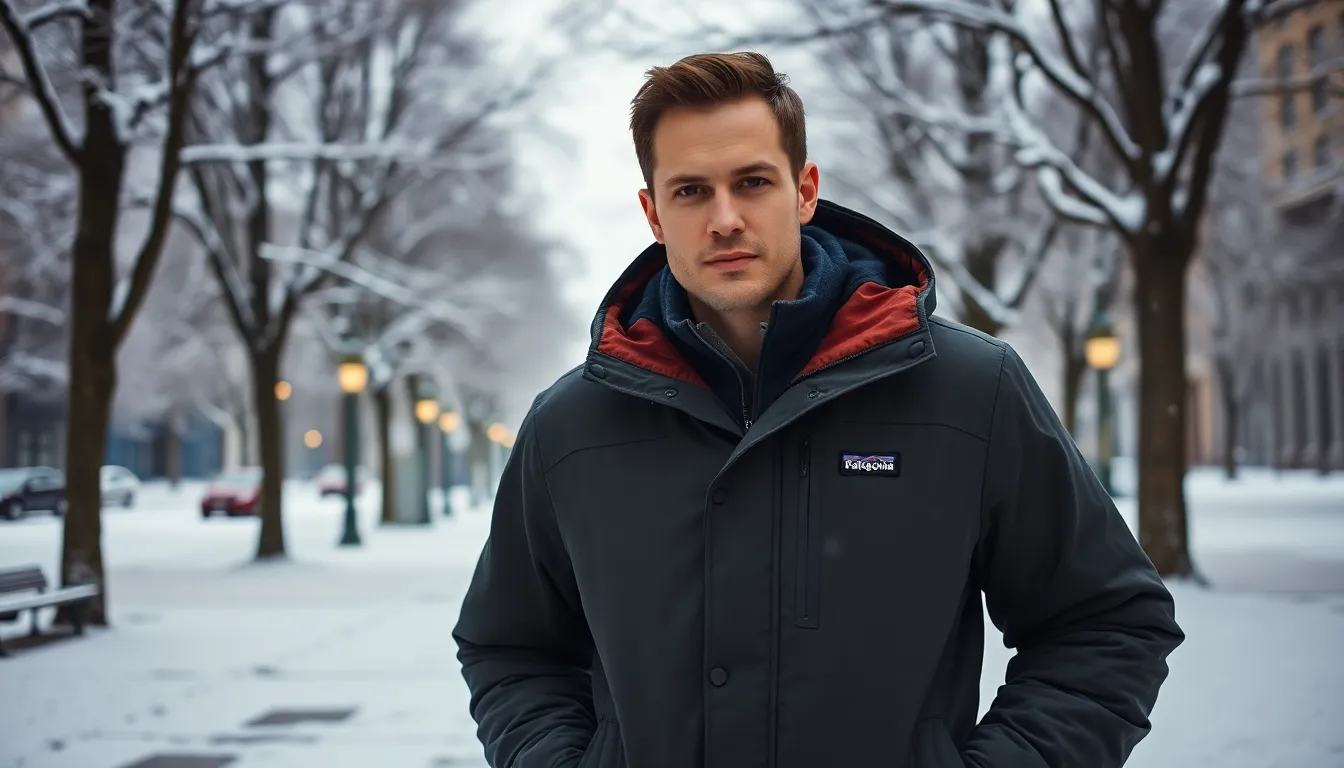
When it comes to investing in quality cold weather protection, understanding price points helps determine the best jacket for your exact needs and winter conditions.
Entry-Level Jackets Under $200
REI Stormhenge 850 Down Hybrid Jacket stands out as our top recommendation for budget conscious buyers seeking reliable winter protection. This jacket delivers competent warmth through quality down insulation while maintaining water repellent properties essential for mild to moderate cold conditions. Performance features include basic windproofing technology and durable construction that handles urban environments and light outdoor activities effectively.
Budget friendly options in this range typically use synthetic insulation or standard down fill, providing decent thermal protection without premium features. Most jackets under $200 offer fundamental weather resistance through DWR coatings and wind resistant fabrics. Value comes from manufacturers focusing on core functionality rather than advanced technical features.
Limitations become apparent during extended exposure to extreme cold or intensive outdoor activities. These jackets work best for casual winter use, daily commuting, and occasional outdoor adventures where maximum performance isn’t critical.
Mid-Range Options Between $200-$500
Patagonia Tres 3-in-1 Parka exemplifies the enhanced quality and versatility available in this price range through removable liners and premium construction materials. This jacket adapts to various weather conditions while incorporating ethically sourced materials and improved waterproofing technology. Technical features expand to include better breathability systems, reinforced stress points, and multi functional design elements.
Mid range jackets strike an optimal balance between performance capabilities and cost effectiveness for most winter users. Enhanced insulation quality provides superior warmth retention compared to entry level options. Manufacturers invest in better fabrics, advanced weatherproofing treatments, and improved durability standards.
These jackets handle frequent winter exposure, urban commuting demands, and moderate outdoor adventures with confidence. Value proposition centers on long term reliability and expanded functionality that justifies the increased investment.
Premium Investment Pieces Over $500
Canada Goose Expedition Parka and Feathered Friends Khumbu represent the pinnacle of winter jacket technology designed for extreme cold environments and expedition level performance. These jackets use high fill power down insulation, advanced fabric systems, and specialized features like fur lined hoods for maximum protection. Construction quality focuses on harsh condition durability with reinforced high wear areas and extended length coverage.
Premium jackets target outdoor enthusiasts, professional users, and individuals prioritizing maximum protection in severe winter weather. Top tier insulation technology delivers superior warmth to weight ratios while maintaining compressibility for travel. Advanced weatherproofing systems provide complete protection against wind, moisture, and temperature extremes.
Investment value comes from exceptional longevity, uncompromising performance standards, and specialized features unavailable in lower price ranges. These jackets excel in sub zero conditions, extended outdoor exposure, and demanding professional applications where failure isn’t acceptable.
| Budget Range | Example Models | Key Features | Best Use Cases |
|---|---|---|---|
| Under $200 | REI Stormhenge 850 Down Hybrid | Basic insulation, water repellent, casual protection | Mild cold, budget conscious buyers, urban use |
| $200-$500 | Patagonia Tres 3-in-1 Parka | Enhanced insulation, waterproof, versatile layering | Regular winter climates, active users, daily wear |
| Over $500 | Canada Goose Expedition, Feathered Friends Khumbu | Premium insulation, extreme cold protection, expedition durability | Severe conditions, professional use, long term investment |
Conclusion
Finding the perfect men’s winter jacket doesn’t have to be overwhelming when you know what to look for. We’ve covered everything from insulation types and weatherproofing technologies to proper sizing and maintenance practices that’ll keep your investment performing for years.
Remember that the best jacket for you depends on your exact needs climate and budget. Whether you’re commuting to work exploring the backcountry or simply running daily errands there’s a winter jacket designed to keep you warm comfortable and stylish.
Take time to consider the features that matter most to your lifestyle. With the right knowledge and careful selection you’ll stay protected throughout even the harshest winter conditions while looking great doing it.
Frequently Asked Questions
What are the main types of insulation used in men’s winter jackets?
The three main types are down insulation, synthetic insulation, and hybrid systems. Down offers the best warmth-to-weight ratio and compressibility but loses effectiveness when wet. Synthetic insulation performs well in wet conditions and dries faster, making it budget-friendly. Hybrid systems combine both materials for optimal performance across varying conditions.
How do I determine the right size for a winter jacket?
Measure your chest, sleeve length, waist, and hips for proper sizing. Allow extra room for layering base and mid layers underneath while maintaining insulation efficiency. Look for adjustable features like cuffs, hoods, and drawcords. The jacket should provide adequate coverage without restricting movement during winter activities.
What waterproof rating should I look for in a winter jacket?
Look for jackets rated at least 10,000mm waterproof rating, which can withstand heavy rain or snow. Higher ratings like 20,000mm offer superior protection. Also check for proven waterproof membranes like GORE-TEX Pro and DWR (Durable Water Repellent) coatings for enhanced weather resistance and durability.
Which brands offer the best men’s winter jackets?
Top premium brands include The North Face, Patagonia, Canada Goose, and Fjallraven for extreme conditions. Budget-friendly options come from REI Co-op, L.L. Bean, and Wantdo. Specialized manufacturers like Feathered Friends and Rab offer expedition-level jackets for the harshest environments and professional outdoor use.
How should I care for and maintain my winter jacket?
Spot clean minor stains and machine wash only when care labels permit. Air dry to maintain insulation properties and avoid heat damage. Store jackets uncompressed in cool, dry places. Regularly inspect for wear, treat stains immediately, and consider professional cleaning for down jackets to preserve their loft and performance.
What’s a reasonable budget for a quality men’s winter jacket?
Entry-level jackets under $200 offer basic protection for moderate conditions. Mid-range options ($200-$500) provide better materials and features like the Patagonia Tres 3-in-1 Parka. Premium jackets over $500, such as Canada Goose Expedition Parka, offer maximum protection for extreme conditions and professional outdoor use.
Can winter jackets be styled for different occasions?
Yes, winter jackets can be styled for various settings. Down jackets and bomber styles work well for casual wear. Classic peacoats project professionalism in business environments. Performance-oriented jackets with technical features are ideal for outdoor activities, while ultralight options offer versatility for active lifestyles and travel.

